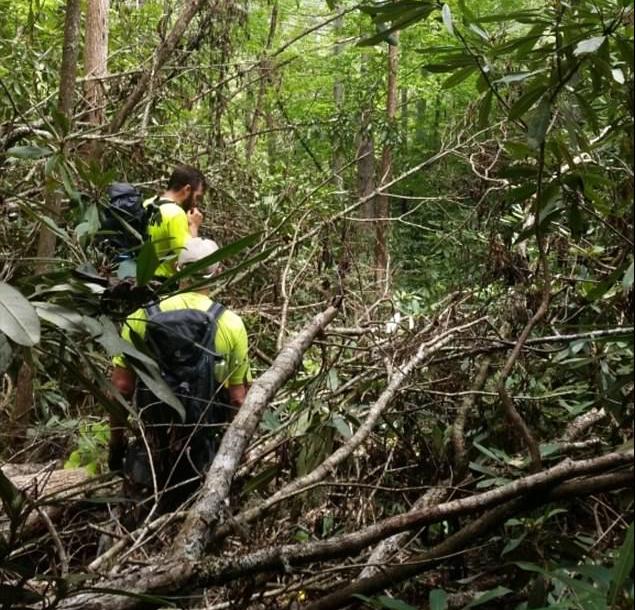I was going up to Mount Lemmon to spend Monday night in a hammock that I was modifying for cold weather, and to enjoy looking at the super moon.
I was going to have lunch with a friend then proceed to the campsite near the top of Mt. Lemmon. The last time I spoke with my friend regarding lunch was Saturday, we were to speak about it again sometime Sunday. We did not do that, and I assumed that lunch was confirmed.
That was the first of several mistakes I made.
I started up Catalina Highway and had plenty of time to stop along the way.
I decided to check out a trail that I had not hiked in several years, Upper Green Mountain. It was about 11 a.m., I decided to go up the trail for about 20 minutes and then back down.
It is a pretty steep trail and pine needles made it difficult to see the trail. I had on a light long-sleeve cotton shirt, my hat, fishing vest (lots of pockets for stuff) and my water bottle with about 25 ounces.
Near the top I remembered that the trail went down the other side. I saw a path that went off trail to an interesting rock formation.
I went there for a little exploration, and headed back.
When I got back to where I went off trail, I had a major unexpected urge to have a BM.
I had taken a little extra magnesium that morning for some left leg cramps. So I got off-trail again, dug a hole, pooped and used about 1/2 of my water to wash my hands.
I looked around but did not see anything that looked like a trail. I thought I got here by going up, so to get back all I needed to do is go down.
Really big mistake.
I headed down for about 15 minutes and did not see the highway as expected. So I picked up my pace and decided to maintain one direction — I kept the sun on my back and headed north.
The terrain was very steep, and starting to get difficult to hike through. After about 1/2 an hour I thought I have to be near the road. Then I came to an area with a impassable cliff on the right and left. I was convinced this was the point of no return, no back tracking. I kept up a fast pace through some pretty difficult terrain, thick areas of shrub oaks and sticker bushes.
But I was still thinking I would find the highway.
After about 1 1/2 to 2 hours of going down the wrong side of the mountain, I realized that I was in really big trouble.
I was lost and would need to spend the night.
I was up on a ridge, looked down and saw a flat area somewhat clear of trees.
I remembered thinking about one of the most important things to do in a survival situation — keep a positive mental attitude. It would not help to be thinking about the mistakes I made that got me lost. I needed to focus on the present.
I started down to the clearing, came across a prickly pear cactus and cut off some pads for food, Great, I had a food source.
I arrived at my campsite and started gathering wood for a fire. I always carry a lighter in my vest, thank God!
While gathering wood I noticed bear poop, many very large piles of it, all around the campsite.
OK, positive mental attitude, fire will keep them away. And in case it didn’t, I tied the larger of my two knives to one of my ski poles.
The fire was in a water erosion ditch so there was no need to build a fire pit and could put longer logs in it and move them towards the fire as needed.
I had about 10 ounces of water left when I remembered another survival technique — I would have to start drinking my own urine.
Eating prickly pear pads have a side effect of diarrhea, which I found out the next day. To borrow a line from the pharmaceutical industry — ask your doctor if prickly pear pads and pee is right for you.
Having a sense of humor helps with positive mental attitude.
Anyway I had a collapsible camping cup in my vest so there was no need to pee in my water bottle while it still had water.
That night it was pretty cold, with a very cool breeze coming down the canyon.
I did not have a flashlight. I had to keep close to the fire, and rotated keeping my back, buttocks and legs warm.
The ground was cold and I couldn’t lay on my back for very long.
Also, I had to keep the fire going so I did not sleep that night
Sometime that night I saw what looked like several bright lights on the east side of the canyon. Could it be people? I shouted out hey, but in a little while realized it was that super moon coming up shining a little light through the pines.
Wow, the super moon was beautiful. I enjoyed the beauty and kept a positive mental attitude.
Time passed incredibly slowly that night.
He managed to make his way out and you can read the rest for yourself if you’re inclined. But listen to me. Drinking your own urine IS NOT a survival technique. It’s a death technique.
Even on day hikes, I take at least the following in a day pack: cordage (550), gun, knife (serrated edge), tactical light, multiple fire starters, rubberized poncho, water, clothing for warmth (some sort of parka even in the summer), usually a light Mylar blanket, and energy bars. At times I’ve carried a compass and maps if I don’t know the area.




